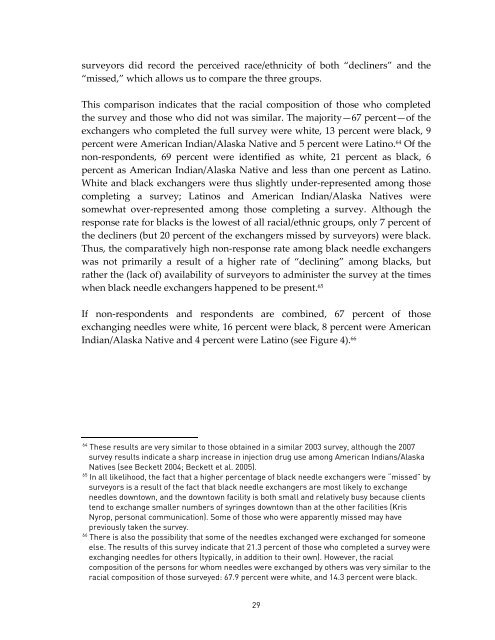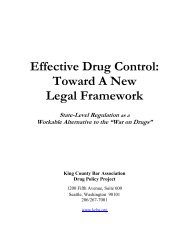RACE AND THE ENFORCEMENT OF DRUG DELIVERY LAWS IN ...
RACE AND THE ENFORCEMENT OF DRUG DELIVERY LAWS IN ...
RACE AND THE ENFORCEMENT OF DRUG DELIVERY LAWS IN ...
You also want an ePaper? Increase the reach of your titles
YUMPU automatically turns print PDFs into web optimized ePapers that Google loves.
surveyors did record the perceived race/ethnicity of both “decliners” and the<br />
“missed,” which allows us to compare the three groups.<br />
This comparison indicates that the racial composition of those who completed<br />
the survey and those who did not was similar. The majority—67 percent—of the<br />
exchangers who completed the full survey were white, 13 percent were black, 9<br />
percent were American Indian/Alaska Native and 5 percent were Latino. 64 Of the<br />
non-respondents, 69 percent were identified as white, 21 percent as black, 6<br />
percent as American Indian/Alaska Native and less than one percent as Latino.<br />
White and black exchangers were thus slightly under-represented among those<br />
completing a survey; Latinos and American Indian/Alaska Natives were<br />
somewhat over-represented among those completing a survey. Although the<br />
response rate for blacks is the lowest of all racial/ethnic groups, only 7 percent of<br />
the decliners (but 20 percent of the exchangers missed by surveyors) were black.<br />
Thus, the comparatively high non-response rate among black needle exchangers<br />
was not primarily a result of a higher rate of “declining” among blacks, but<br />
rather the (lack of) availability of surveyors to administer the survey at the times<br />
when black needle exchangers happened to be present. 65<br />
If non-respondents and respondents are combined, 67 percent of those<br />
exchanging needles were white, 16 percent were black, 8 percent were American<br />
Indian/Alaska Native and 4 percent were Latino (see Figure 4). 66<br />
64 These results are very similar to those obtained in a similar 2003 survey, although the 2007<br />
survey results indicate a sharp increase in injection drug use among American Indians/Alaska<br />
Natives (see Beckett 2004; Beckett et al. 2005).<br />
65 In all likelihood, the fact that a higher percentage of black needle exchangers were “missed” by<br />
surveyors is a result of the fact that black needle exchangers are most likely to exchange<br />
needles downtown, and the downtown facility is both small and relatively busy because clients<br />
tend to exchange smaller numbers of syringes downtown than at the other facilities (Kris<br />
Nyrop, personal communication). Some of those who were apparently missed may have<br />
previously taken the survey.<br />
66<br />
There is also the possibility that some of the needles exchanged were exchanged for someone<br />
else. The results of this survey indicate that 21.3 percent of those who completed a survey were<br />
exchanging needles for others (typically, in addition to their own). However, the racial<br />
composition of the persons for whom needles were exchanged by others was very similar to the<br />
racial composition of those surveyed: 67.9 percent were white, and 14.3 percent were black.<br />
29

















